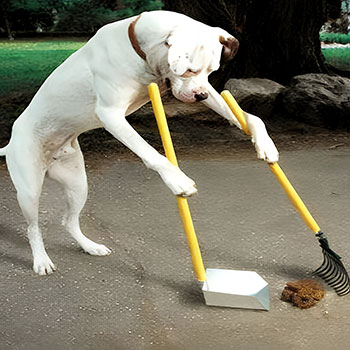Picking Up After Your Pet Becomes Law
Eric Mayer, Poo Prints
 A company called Poo Prints started when one of the research scientists at Bio Pet Vet Lab had a pet waste problem in one of the apartment complexes where they lived. They then thought how could they solve this problem? They had the lab and the DNA technology; so they knew there had to be some way to come up with a solution. That is how Poo Prints was born.
A company called Poo Prints started when one of the research scientists at Bio Pet Vet Lab had a pet waste problem in one of the apartment complexes where they lived. They then thought how could they solve this problem? They had the lab and the DNA technology; so they knew there had to be some way to come up with a solution. That is how Poo Prints was born.
In order for this to work, the managed communities that use Poo Prints collect a small cheek swab sample of pets' DNA, for all of the pets in the community. These are then held in a secure online database. So if there is ever any waste found in a community, a small sample can be sent in to the laboratory for analysis, matched up and identify the "Poopatrator!"
But what if you have one of those pets that likes to eat other dog's poop? Will both DNA's show up? Poo Prints is able to detect whether or not the sample comes from one or more different pets.
 It's good if you clean up after your pet, as it creates a nice, clean, green living environment. It also prevents the bacteria from pet waste from washing into the water supply when it rains. Pet waste that is left on the ground also harbors parasites for other animals, as well as other infectious diseases. Keep your pets healthy (and people too) and keep that poop picked up.
It's good if you clean up after your pet, as it creates a nice, clean, green living environment. It also prevents the bacteria from pet waste from washing into the water supply when it rains. Pet waste that is left on the ground also harbors parasites for other animals, as well as other infectious diseases. Keep your pets healthy (and people too) and keep that poop picked up.
Most major cities have a "Pooper-Scooper" law on the books. Basically it states that if you are walking your pet in any public area, or any private areas that are not your own, you have to pick up after your pet's waste. Unfortunately, these laws are not always being followed and are hard to enforce.
The company sells DNA kits that come with a swab to take an oral sample from a pet that is then recorded in a world pet registry. Poo Prints also sells testing kits to sample dog waste, which can be matched to pets recorded in the registry.
Visit Website
The Underwater Dog Guy
Seth Casteel, Underwater Dogs
 Photographer Seth Casteel said that his photographing dogs underwater was a "Happy Accident." Dogs are his passion, his career and his entire life.
Photographer Seth Casteel said that his photographing dogs underwater was a "Happy Accident." Dogs are his passion, his career and his entire life.
Seth is interested in the emotion of dogs. He was originally photographing a little Cavalier King Charles Spaniel named Buster on land, telling his story through photos. All of a sudden, Buster decided that he would rather do a swimming pool shoot and he jumped in the pool over and over again, chasing his ball. Seth was watching him the whole time, where Buster was actually going completely underwater to retrieve his ball, and having so much fun.
Seth then started to wonder what it looked like when the dog was underwater. So he ran out and bought a little point-and-shoot underwater camera and came back and started shooting pictures underwater. This was the beginning of the series of Underwater Dogs.
 The underwater pictures that Seth was able to capture were one-of-a-kind. They were hilarious! His first book, Underwater Dogs, instantly become a bestseller, all from a guy who was just fooling around in a pool with dogs!
The underwater pictures that Seth was able to capture were one-of-a-kind. They were hilarious! His first book, Underwater Dogs, instantly become a bestseller, all from a guy who was just fooling around in a pool with dogs!
Seth Casteel is passionate about helping animals and believes every pet deserves a loving home. He volunteers with animal shelters and rescues all over the country, professionally photographing dogs and cats to give them a better chance of finding forever homes. Seth's professional photos resulted in increased adoptions and helped generate more traffic to the shelters and rescues.
Visit Website
Pooches For Parkinson's
Roy and Lynn's Rodens' Parkinson's Ride Across America!
 Roy & Lynn Roden travelled by bicycle from Seattle, Washington to Miami, Florida to raise awareness for Parkinson's Disease. They took on this 4,500-mile journey with their two dogs, Oliver (a 65 pound Springer Spaniel) and Samantha (a 90 pound Labradoodle).
Roy & Lynn Roden travelled by bicycle from Seattle, Washington to Miami, Florida to raise awareness for Parkinson's Disease. They took on this 4,500-mile journey with their two dogs, Oliver (a 65 pound Springer Spaniel) and Samantha (a 90 pound Labradoodle).
Roy told us about his brain surgery, called DBS, which stands for Deep Brain Stimulation. He said it was like an outpatient surgery and was done while he was awake. This was because he had to be able to follow commands during the surgery. He also told us that his wife caught him at a weak moment after the brain surgery, when she came up with the idea to bike ride across America. The bike ride was not only to raise awareness about Parkinson's Disease, but to also talk about the many options available to people who have PD. He mentioned that beside his DBS surgery he received, where he basically received a pacemaker for his brain, there are other options available such as the use of drugs and exercise. Roy stated, "It's not the end of the world!"
Roy's Story: Cat's out of the bag.... so here's his Story. It all started years ago with a thumb twitch on his right hand, not always...just when he positioned his palm face up. It was a nurse practitioner that mentioned the possibility of Essential tremors or possibly even Parkinson's Disease. The findings were conclusive to a 99-percent probability of accuracy. His twitch now had a name. Parkinson's Disease (PD).
He became an active advocate for Parkinson's Disease. He organized fundraisers for the National Parkinson's Foundation as well as the University of Miami Miller School of Medicine at Olympia Gym in Aventura.
 He made it his mission to educate people living with PD and their caregivers about the opportunity to participate in clinical studies that would hopefully better treat or better yet, cure Parkinson's.
He made it his mission to educate people living with PD and their caregivers about the opportunity to participate in clinical studies that would hopefully better treat or better yet, cure Parkinson's.
Roy underwent Deep Brain Stimulation (DBS) in an effort to reduce his physical motor symptoms caused by Parkinson's' and hopefully to cut down on the dozens of medications he was taking every day. Embarking on this journey, he hoped to prove to himself and others that he may have Parkinson's, but Parkinson's does not have him. Together everyone can make a difference and find a cure.
Lynn's Story: Having been married for a little over 4 years and struggling with Roy's Parkinson's diagnosis as their 1st year anniversary present, they decided, with their dogs, Oliver and Samantha, to take a 4,000 mile cross-country journey via bicycle to help put in perspective their personal struggles, both individually and as a couple
This journey, through the grueling physical trial of biking cross-country, would mold their confidence of themselves and each other and strengthen their bond and that together they could overcome their obstacles. In the hopes that by being selfless, they would find themselves and find their way through this world of Parkinson's.
The Cause: The more their message gets out there, the more help, awareness and education they could provide to facilitate people living with PD and their caregivers about the opportunity to participate in clinical studies that would hopefully better treat or better yet, cure Parkinson's.
PD FACTS
- It is estimated that about 1.5 million Americans have Parkinson Disease.
- Approximately 60,000 people are diagnosed each year.
- About 10%-20% of those diagnosed with PD are under the age of 50, and about half of those are diagnosed before age 40. Some are even diagnosed as early as the age of 21.
- Someone is diagnosed with Parkinson Disease every 9 minutes.
It's Not Doggie Asthma - It's a Reverse Sneeze - Dr. Debbie
 What dog owner hasn't heard that frightening sound that dogs make - part cough, part sneeze and often described as a dog being unable to catch his breath. But it really isn't asthma, or some kind of bone stuck in your dog's throat - it's a reverse sneeze. So before you panic and run into the veterinary office on emergency, ensure you know what a reverse sneeze is.
What dog owner hasn't heard that frightening sound that dogs make - part cough, part sneeze and often described as a dog being unable to catch his breath. But it really isn't asthma, or some kind of bone stuck in your dog's throat - it's a reverse sneeze. So before you panic and run into the veterinary office on emergency, ensure you know what a reverse sneeze is.
Meet the Reverse Sneeze
A reverse sneeze is a respiratory sound in a category all its own. Also known as a pharyngeal gag reflex or backwards sneeze, the reverse sneeze is a commonly observed respiratory sound in dogs and less commonly in cats. While a true sneeze occurs on the exhale, the reverse sneeze occurs as the dog inhales. The result is a reverberating snorting, wheezing, episodic sound that lasts for a few seconds to a minute or two. A reverse sneeze is a completely harmless sound and dogs do not suffer any immediate health threat from these episodes.
How can you tell it's a reverse sneeze?
There is no easy explanation of the sound - you just have to hear it and you'll recognize it. Click to see and hear an example of a dog's reverse sneeze episode.
Part of my enjoyment on the weekly national radio program, Animal Radio, is describing the peculiar smells, sounds and essences of veterinary medicine with our listeners. On many an occasion when speaking to callers, I have re-created the sounds of reverse sneezing. I'm no Rich Little, but I do take pride in my impersonation of a canine reverse sneeze, which is admittedly better in person with the visuals to complement the throaty sound.
Characteristics of a dog displaying a reverse sneeze include:
- Vibrational coughing/wheezing sound
- Stiff, extended neck
- Facial grimace
- No discharge from nose
- Not followed by coughing or vomiting up material
- Not involving collapse episodes
- Animal is completely normal after event
 What causes a reverse sneeze?
What causes a reverse sneeze?
Some reverse sneeze episodes occur when a dog gets very excited or pulls against a leash. Brachycephalic breeds (short faced breeds) like Pugs and Boston terriers commonly display reverse sneezing due to their upper airway conformation.
Allergies, respiratory infections, nasal mites, inhaled foreign bodies and masses can also trigger reverse sneezing. Dogs with inflammatory conditions such as lymphoplasmacytic rhinitis can also display bouts of reverse sneezing. And sometimes reverse sneezing occurs in the wee hours of the night, while a dog is sleeping, for no apparent reason. In fact, many veterinarians receive panicked phone calls at 2am from pet owners, concerned of impending asthma attacks or respiratory arrest, only to have it turn out just to be a typical case of reverse sneezing.
What to Do?
There is no required treatment for a reverse sneeze episode. However, I recommend stroking a dog's throat while gently speaking to him in a calm manner until the episode subsides. Some advocate closing/pinching the nostrils off, which forces a dog to swallow and curtails the reverse sneeze episode. Whatever the approach, reverse sneezing episodes are over within minutes, so no emergency treatment is indicated. Antihistamines may be prescribed to minimize reverse sneezing episodes.
When to Worry?
If all of a sudden your dog is having repeated bouts of reverse sneezing, evaluation by your veterinarian is indicated. Consult with your veterinarian if your dog is reverse sneezing along with other symptoms such as facial rubbing, nasal bleeding, nasal discharge, coughing, or significant sneezing episodes.
Nasal mites are a common cause of reverse sneezing and may be noted after a recent boarding visit, especially if multiple dogs in a household are involved. Nasal mite treatment is easily pursued with anti-parasite injections of ivermectin (or in collie breeds - the alternative Milbemycin.) If reverse sneezing is excessive and prolonged, the nasal and pharyngeal areas should be evaluated by a veterinarian through rhinoscopy - a procedure performed under anesthesia in which the nasal passages and pharyngeal areas are visualized with an endoscope, a micro camera. This is how foreign objects and masses are typically identified. In other cases, further tests may be needed including a CT scan or with biopsy samples from sinus passages.
Final Thought
The good news is that most of reverse sneezing episodes are harmless, and do not indicate any serious illness. Arm yourself with information by learning what a reverse sneeze looks like and you may save yourself an unwanted emergency veterinary visit over this peculiar but non-life threatening occurrence.
Featured veterinarian known as "Dr. Debbie" on national pet radio program, Animal Radio. Ebook author of "Yorkshire Terriers: How to Be Your Dog's Best Friend"; "Pugs: How to Be Your Dog's Best Friend"; "Mini Schnauzers: How to Be Your Dog's Best Friend"; and "Shih Tzu: How to Be Your Dog's Best Friend." Dr. Debbie's books.
Visit Website
The Dogfather's Grooming Tip with Joey Villani
Bar Soap Dog Shampoo
 Dog shampoo makers have put the shampoo in a bar soap form. But how does this work on your pet? While it might be easier and more convenient to grab a bar of soap when bathing your pet, it is more of a sales pitch than anything else.
Dog shampoo makers have put the shampoo in a bar soap form. But how does this work on your pet? While it might be easier and more convenient to grab a bar of soap when bathing your pet, it is more of a sales pitch than anything else.
Joey warns people to stay away from shampoo in bar soap form! The best example Joey can give is if you don't clean your shower regularly, you can get a soap buildup. That buildup is from what is contained in the bar soap. It's not the soap itself, but the scum. If you use a liquid body wash, there will not be any soap scum. But in bar soap, what holds it together is actually what causes that scum.
If you use bar shampoo in your pet's coat, you cannot rinse it clean. There is a reason why people don't use bar soap in their hair. Bar soap will leave a tremendous amount of residue. This residue will buildup over time, dull the coat and cause knots and tangles. This may even cause itching for dogs with sensitive skin.
Bar soap dog shampoo is a great concept and neat idea, but they do not make bar soaps for pets (and Joey knows them all) that will not leave a residue. Instead, use a good quality liquid shampoo.
Animal Radio News with Stacey Cohen
 Private Security Guarded Goat
Private Security Guarded Goat
The city of Gävle, Sweden, went to great lengths to protect a goat, because this was no ordinary goat. The horned animal in question was a 42-and-a-half-foot tall straw goat that the city erected every year as part of a Christmas tradition that started in 1966. And while the goat had become very popular in the Swedish city, it had also become a target for vandals and arsonists. So the city took no chances, and hired private security guards to keep the Gävle Christmas goat safe.
Dogs Shot By Police on The Rise
In response to an alleged increase of dog shootings by police officers, several people, including owners of murdered pets, started using Facebook as a tool to increase awareness of the problem and seek change to police policies toward dogs. Videos of dog shootings are all over the Internet and it seems like there's a new one every week. Unfortunately, the number of videos online is a misrepresentation of the high number of dog shootings. It's impossible to determine the exact number of dog shootings by police officers because every police department in the country doesn't keep records. However, in Milwaukee, the 28th largest city in the country, a lawsuit claimed that more than 400 dogs were shot to death by police officers over a nine-year period. If those numbers are similar for cities around the U.S., a low estimate for the annual number of dogs killed per year by police in the 30 largest cities alone is 1,100. In addition, a dog-training manual for police published by the Department of Justice showed that most police shooting incidents involve dogs.
 Millionaires Have Gone To The Dogs
Millionaires Have Gone To The Dogs
Dogs And Millionaires Have A Lot In Common. They are relentless opportunists (especially when it comes to rewards). They come in all shapes, sizes and colors. They defend their turf. And in general, they don't like cats. Perhaps that explained a survey that showed that millionaires were far more dog friendly than the rest of Americans. According to a study, 58-percent of millionaire pet owners have a dog; 37-percent own a cat. Only 3-percent keep fish, 2-percent birds and 2-percent have a horse. Why have millionaires gone to the dogs? Dogs provide one thing especially important to the wealthy: "unconditional love." "You don't get that from a cat," Dogs are like children for some families, except they don't mess up in college or run off with money. Sometimes it's easy to see why dogs are the favorite child." Plus, millionaires know that dogs don't love them for their money. It's unbiased love and money doesn't enter into the equation. Millionaires show their love for their dogs in part by their spending. One quarter of millionaire pet owners spend more than $1,000 a year on their pets every year, while more than half spend more than $500 a year.
North Korean Report Said Unicorns Existed
Those who thought unicorns were relegated only to annals of fairy tales and storybooks didn't need to look any further than North Korea for confirmation the mythical beasts once existed. A professor with Tufts University analyzed the revelation about a unicorn lair. It seems archaeologists from the History Institute of North Korea had "reconfirmed" a unicorn lair that was present around the year 277 B.C. It was purportedly located right in the capital city of Pyongyang. The lair was discovered nearby a rectangular rock with the words "Unicorn Lair" carved into it. Some media reports indicated the article might have been a "tongue-in-cheek" response to humor newspaper "The Onion's" fictional article that North Korean leader Kim Jong-un was once named the "sexiest man alive."
 Simon Cowell Wanted A Penguin
Simon Cowell Wanted A Penguin
Simon Cowell is a big fan of flippers, and we're not talking about beach gear. Simon, who is known for being a bit of a curmudgeon, apparently likes penguins so much that he said he would love to have one of the flightless birds to call his own. "Watching Mr. Poppers Penguins again," Simon once tweeted. "I love this film. I really do want a pet penguin." The 2011 film, based on a children's book of the same name, stars Jim Carrey as a divorced real estate entrepreneur who is bequeathed a gentoo penguin named Captain in his late father's will. But when he tries to send back the penguin, due to a mix up, five more arrive. Suddenly he's sharing his New York City apartment, which doesn't allow pets, with a bunch of birds! Of course, if Cowell really wanted a penguin, we're sure he has the cash to afford one. But, he'd have to purchase an entire zoo, as it's not legal to keep a penguin as a domesticated pet in the United States.
 Listen to the entire Podcast of this show (#1307)
Listen to the entire Podcast of this show (#1307)





